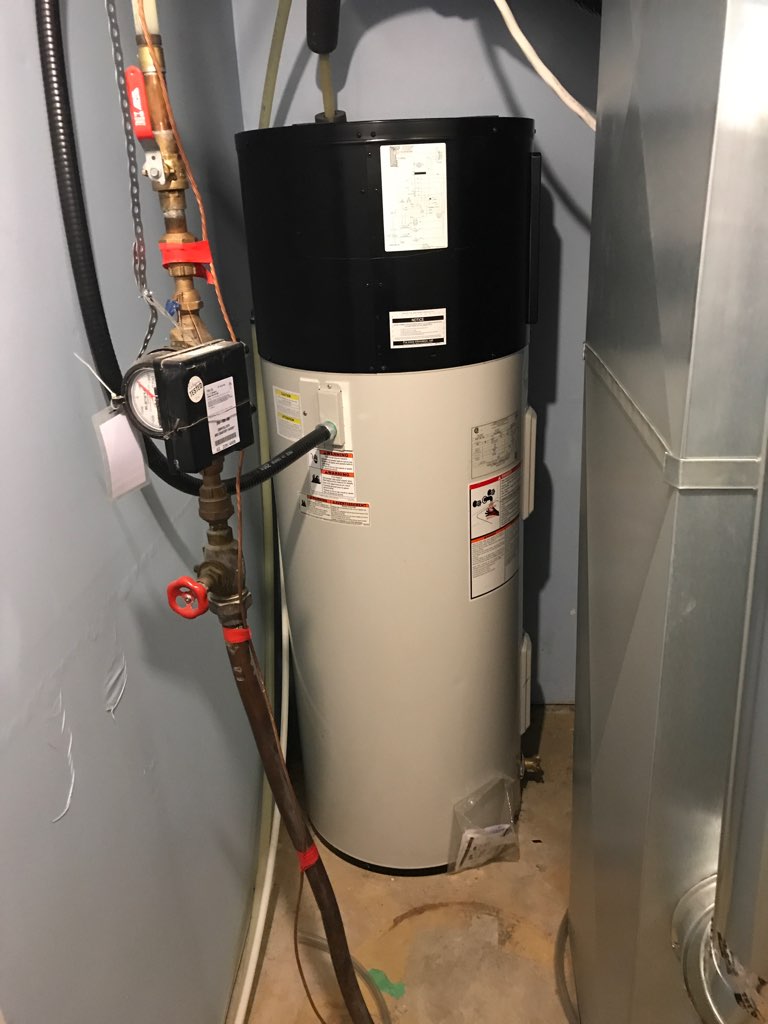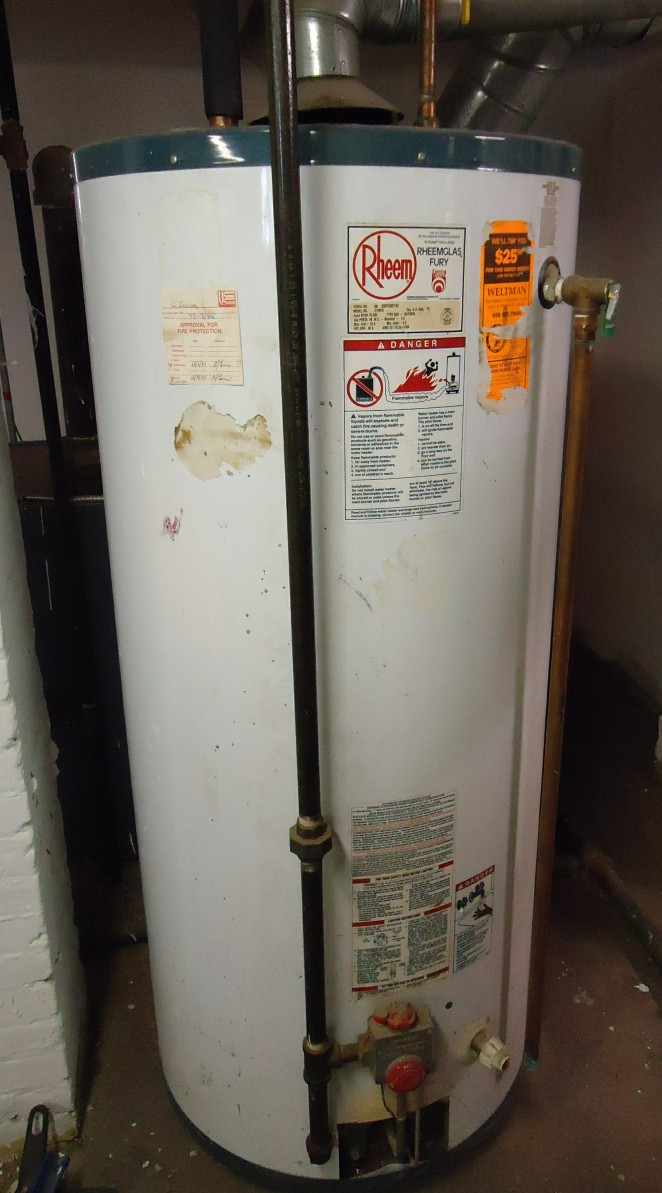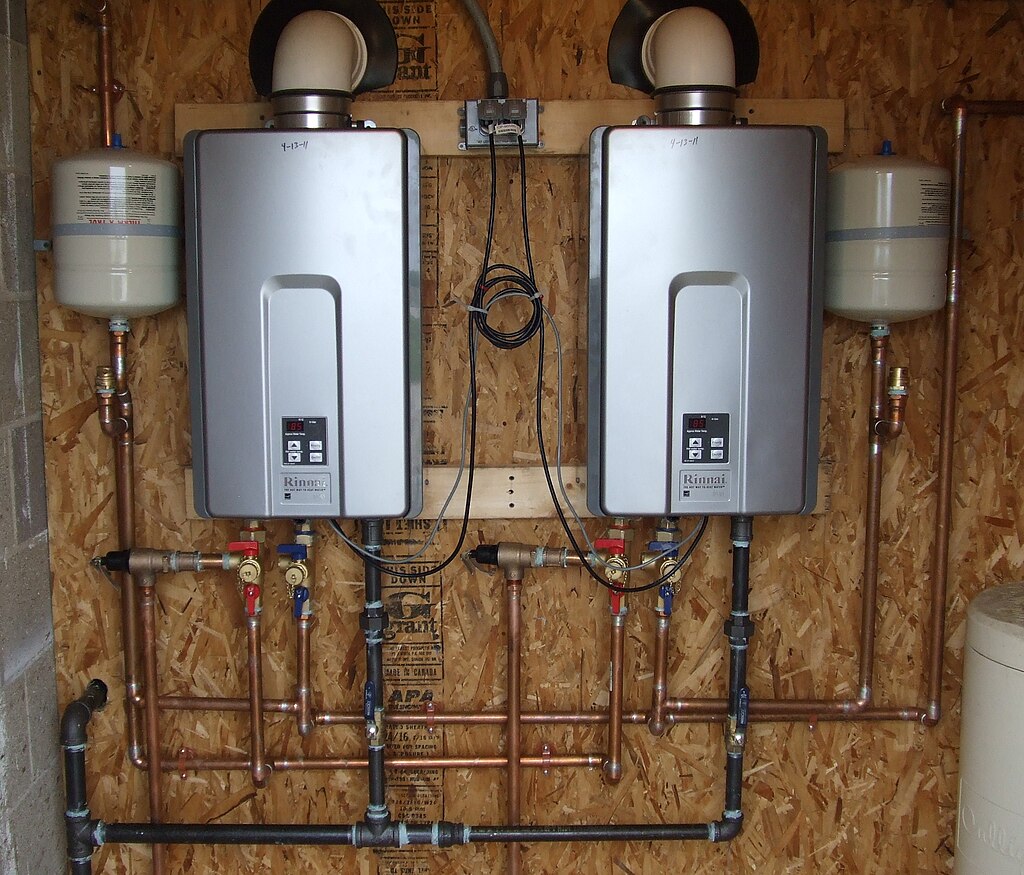Federal Government Announces Overdue Raised Efficiency Standards for Residential Water Heaters
. Posted in News - 0 Comments
By Eric Weld, MassLandlords, Inc.
The federal government’s recent adoption of raised energy efficiency standards for residential water heaters is expected to trigger a big boost in heat pump conversions for heating water. The raised standards are also projected to save consumers billions of dollars on energy bills, ease pressure on electric grids and help meet states’ decarbonization goals.

The Department of Energy’s recently raised water efficiency standards is projected to result in a 50%-plus increase in heat pump water heater sales such as this one when they take effect in 2029. Today, only about 3% of water heaters use heat pump technology. Image: cc by-sa David Dodge, Green Energy Futures, flickr.
The new standards were announced in late April 2024 by the U.S. Department of Energy (DOE) and will go into effect in 2029, five years after the date of publication, as mandated by federal law. Once the higher standards kick in, they are set at such a level that most water heaters of commonly used sizes will be required to meet higher efficiencies using heat pump technology.
The department projects that the new standards will result in a 50%-plus increase in heat pump technology for electric water heaters manufactured in 2029 and beyond. Only about 3% of these water heaters use heat pumps today, notes the announcement.

Most American homes use storage tank water heaters, either powered by electric resistance or, like this one, by gas. Storage tank heaters draw in water to a large tank, typically 50-80 gallons, and run power as necessary, 24 hours a day, to keep water in the tank hot and ready for use when taps are turned on. Image: cc by-sa tomwsulcer Wikimedia commons.
Water Heater Efficiency Upgrade Long Overdue
Electric water heaters are the current leaders of the residential product market, having nudged ahead of gas-fired water heaters in recent years.
The new efficiency standards apply to gas- and oil-powered and electric resistance storage water heaters, as well as instantaneous (aka tankless or “on-demand”) gas-fired and electric water heaters, and tabletop and grid-enabled water heaters. Storage tank water heaters across energy uses are by far the most common option for American households. But tankless water heaters are gaining market share in recent years. These models can be more efficient because they only heat water as it is needed, as opposed to constantly maintaining a tank of heated water. They are also smaller and take up less space.
The DOE estimates that the raised efficiency standards will save homeowners about $7.6 billion annually on energy and water bills. They will also reduce collective use of electric grids, a growing concern as millions of households convert to all-electric energy. And over a 30-year span, as Massachusetts and other states aim to eliminate carbon emissions, these standards are expected to reduce polluting carbon emissions by 332 million metric tons nationally. That’s the equivalent of carbon emissions of nearly 43 million American homes each year, the DOE estimates, and is “the largest savings ever from a single DOE efficiency standard.”
This is an efficiency standard update that’s long overdue. Water heating technology and capabilities have vastly improved since the last time efficiency standards were updated for these products in 2010. The Biden administration has worked to update a slew of energy efficiency standards that had long gone unattended, including standards for lightbulbs, heat pumps, air conditioners, kitchen appliances, commercial and industrial equipment and affordable housing.
Reducing water heater energy is an essential component for meeting carbon dioxide emission reductions.
Time to Convert Water Heaters to Heat Pumps
Heating water takes up a large percentage of home energy, some 18%, the second-largest energy user next to heating and cooling. And while home heating/cooling has seen a substantial uptick in heat pump adoption, water heating has not. Though heat pump water heater (HPWH) sales have been on the increase in recent years, they still accounted for only 2% of the water heater market in 2022. And while electric water heater sales have surpassed gas-powered water heaters, most of those are still far less efficient electric resistance units. A percentage of homes also uses oil and propane to power water heaters. A smaller percentage uses solar water heaters.
For many heater types and uses, complying with the new efficiency standards will only be achievable by using heat pumps.
Converting homes and multifamilies to HPWHs has become a pressing concern as part of Massachusetts’ pursuit of carbon neutrality. Even if 100% of home and building owners were to successfully adopt heat pumps for heating and cooling, failing to also convert water heating would result in a sizable shortfall of our decarbonization goals.

Tankless water heaters – also known as demand-type or instantaneous – such as these Rennai gas-powered units, are becoming more common in American homes. Instead of storing and maintaining hot water around the clock, tankless heaters bring cold water into the unit as hot water taps are turned on, sends the water through a heat exchanger and runs the hot water to the faucet as needed. Image: cc by-sa Behrat Wikimedia commons.
Commercial Water Heater Standards Already Raised
On Oct. 6, 2023, the federal government approved updated efficiency standards for commercial gas water heaters, under the Energy Policy and Conservation Act (EPCA). These raised standards apply to commercial gas-fired storage and tankless water heaters. The rule does not apply to electric water heaters.
The new standards will take effect by EPCA mandate on Oct. 6, 2026, three years to the day that the standards were published by DOE.
Commercial gas water heater standards are measured in Thermal Efficiency (TE). Commercial gas storage water heaters will be required to have TE of 95%, while tankless products will be required to rate TEs of at least 96%. To achieve these standards will not necessitate use of heat pump technology across the commercial sector. Rather, DOE documents cite the need for several technology changes: “Condensing heat exchanger, forced draft, blower, premix burner, increased heat exchanger surface area.” Residential systems are the first to move toward “all heat dump” because residential hot water is used in bursts that give heat pumps adequate recovery time.
Higher UEF = Better Efficiency
Residential water heater efficiency is measured by the DOE using a metric called the Uniform Efficiency Factor (UEF). This is a replacement of the Efficiency Factor (EF) metric used before 2017. UEF aims to make measurements more consistent across products, sizes and real-world usages.
UEF measures efficiency by comparing the energy used by a water heater to do the work of heating water versus the percentage that is dissipated (i.e., only heating surrounding product components and air). The higher the UEF, the more efficient the water heater, and the less it will cost to run. The UEF metric breaks down all water heaters into categories of daily usages, such as low, medium and high.
Heat pump water heaters consistently reach much higher UEFs than other model types. Gas-fired and electric resistance water heaters (tankless and storage tank) might score UEFs in a range between 0.65 and 0.95, meaning they can operate at 65% to 95% efficiency. At the high level, this means 5% of energy used to run the unit is wasted. Again, tankless heaters may achieve better UEFs than storage tank products. But heat pump water heaters at all usage levels far surpass ratings of conventional types with UEFs ranging between 2.75 and 3.5. In other words, a heat pump water heater produces heated water at a rate of 2.75 to 3.5 times the energy used to operate the product, measured in kilowatt/hours (kWh). This is possible because heat pump water heaters carry heat from the air around them into the water. A small amount of energy input carries a lot of heat.
Examples of new regulations include electric storage water heaters of more than 55 gallons and less than 120 gallons (a common residential size), which will be required to have a UEF of between 1.9 and 2.4, depending on draw size and rated storage volume. Instantaneous electric water heaters will be required to rate UEFs between 0.91 and 0.92 (a value less than one implies it is mostly if not all electric resistance, without a heat pump). All new standards are listed for each water heater type in an Electronic Code of Federal Regulations (ECFR) chart.
This higher efficiency will translate into energy savings every time hot water is used, adding up to thousands of dollars over the life of the water heater.
Advanced Water Heating Initiative (AWHI) to Thank
This dramatic reduction in emissions is possible because of the work of a nationally supported, locally run partnership called the Advanced Water Heating Initiative, based in Portland, Ore. This organization has collected all the U.S. water heater manufacturers to share best practices and collaborate on heat pump water heaters. They hold quarterly meetings, which MassLandlords Executive Director Doug Quattrochi attends as a stakeholder participant.
“It’s hugely exciting to see AWHI at work,” said Quattrochi. “They have managed to pull together everyone, including plumbers, developers, manufacturers, scientists and public officials. And they’re really doing it. These emissions reductions are real and massive, and the cost savings are there, too.”
AWHI members will likely play a significant role in Massachusetts starting in 2025, when heat pump water heaters are expected to be funded at 100% in certain environmental justice communities.
Don’t Forget Hot Water Conservation
In addition to converting to more efficient HPWHs, water heating savings could also be realized by habit and usage changes. Americans use a lot of hot water, 80 to 120 gallons a day for the average household, for washing dishes, bathing, laundry and other uses. Our penchant for hot water costs us $400 to $600 per year.
Strategic hot water use can be an important way to kill germs and effectively clean food off dishes and daily grime and oils off of bodies. But a few simple changes can reduce usage significantly and save energy.
Most simply, telling your renters to set their washing machine for warm or even cold water can save a surprising amount of energy over the course of a year. Modern laundry detergents are formulated to clean just as effectively at lower temperatures, so there’s usually no reason to wash clothes with hot water.
Also, wherever possible, install low-flow fixtures in all showers and faucets. Have a plumber check for and fix any pipe leaks and insulate hot-water lines.
Maybe most importantly, invest in newer, Energy Star-certified appliances like dish and clothes washers. The biggest cost of washing clothes and dishes comes from heating the water. If your renters use cold water for washing clothes and a more efficient dishwasher, they will save on that ongoing energy cost and you will tend to experience longer tenancies with less turnover.
And certainly, in the next five years, in the interim until compliance with the new DOE efficiency standards becomes mandatory, replace your conventional water heater with a heat pump model at the first opportunity. It is a wise and cost-effective practice to know your “end of life” year for each water heater and to replace it preemptively rather than waiting till it breaks or dies.




